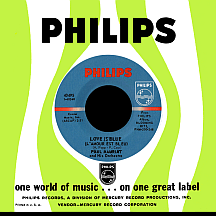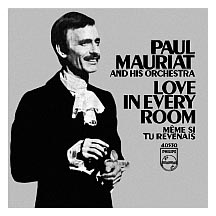PAUL MAURIAT
Love is Blue (L'Amour est Bleu)
Instrumental recordings had been a major component of popular music dating to the classical period of more than two hundred years ago. By the early 1960s the nonvocal art form had been tweaked and altered to encompass a wide variety of domestic and worldwide influences and was still going strong, accounting for about nine percent of all top 40 hits in the U.S. from 1960 to 1963; that statistic dropped by more than half between '64 and '67, with only a handful of those mid-decade hits reaching the top ten. As musical trends evolved, the wordless wonders that had been so big in the '50s and early '60s may have seemed poised to fall out of favor...that is, until classically-trained pop conductor-songwriter Paul Mauriat scored the surprise smash of early 1968, the wistfully romantic "Love is Blue." The melody was composed by Andre Popp and lyrics were provided by Pierre Cour; the team's previous claim-to-fame, "Tom Pillibi," was performed by French songstress Jacqueline Boyer in the 1960 Eurovision contest and took first place. Prior to that, Popp had written "Portuguese Washerwomen" with lyricist Roger Lucchesi, an instrumental hit for American pianist Joe "Fingers" Carr (real name: Lou Busch) in 1956.
Mauriat was born and raised in Marseille on the Mediterranean, his interest in jazz fueling a desire to play piano. While studying at the Marseille Conservatory, he shifted gears to the more demanding classical field, though the band he formed in 1942, at the height of World War II, played primarily pop and jazz tunes, inspired by a path previously taken by fellow Frenchman Frank Pourcel. Moving to Paris in 1957, Mauriat began using pseudonyms, matching his alter egos to different genres; he arranged the music for the Oscar-winning Greek film Never on Sunday using the name Nico Papadopoulos, though the songs were actually composed by Manos Hadjidakis (a real person); a number of other movie projects were executed in similar fashion. Paul also employed this strategy when publishing songs he'd written. As Del Roma, he and Pourcel (calling himself J.Y. Stole) composed "Chariot." The song became a hit in France in 1962 for British singer Petula Clark, then an English translation by Norman Gimbel, "I Will Follow Him," became a million seller for 15-year-old Little Peggy March the following year...Paul's first U.S. number one hit!
In 1965 he formed Le Grand Orchestre de Paul Mauriat and signed with Netherlands-based company Philips Records (his output appeared on the label in France, the U.K., the U.S.A. and many other countries). His lush instrumental cover versions of songs like Clark's "I Know a Place," the '66 Dusty Springfield hit "You Don't Have to Say You Love Me" and Sandie Shaw's '67 Eurovision victor "Puppet on a String" caught on across the globe. Then came "Love is Blue" and Mauriat's pseudonymic efforts to avoid becoming a household name to a billion people were shattered (though not everyone was able to get a handle on how it was pronounced).
The record quietly slipped into the national charts the first week of the new year, gradually working its way to the number one spot in February; the album Blooming Hits went to the top a few weeks later, extending Paul's chart-topping ride into April. On the easy listening charts, the single spent eleven weeks at number one, a longevity record that stood for 25 years. Many artists raced to get cover versions on the market; Lawrence Welk posted decent sales with his instrumental version on the Ranwood Records LP Love is Blue. Al Martino led the charge of vocal renditions, getting the most out of the gloomy '...blue is my world, now I'm without you...' lyrics. Manny Kellem's vocal chorus cover scraped the bottom of the charts and Parisian belle Claudine Longet's version in French also reached the U.S. singles chart while Johnny Mathis opted to make it the title track of his 35th album. In the summer of '69, The Dells went top 30 with a medley of "Love is Blue" and Arthur Hamilton's "I Can Sing a Rainbow." Two years later, Steve Lawrence and Eydie Gorme took the same approach, combining the song with "Autumn Leaves."
A couple of minor '68 hits followed Mauriat's multi-million mother of all E-Z instros: "Love in Every Room" is equally as brilliant as its predecessor (as "Meme Si Tu Revenais," it had been a vocal hit for French star Claude Francois in 1965) and movie theme "Chitty Chitty Bang Bang" cast the wonder of Dick Van Dyke's flying car over a wider landscape...if that's possible. Paul's place among the world's top orchestra leaders was assured; he continued recording and conducting orchestras for three decades after his peak year, composing and arranging music along the way for several popular singers including Mireille Mathieu, for whom he played a key role in her ascendancy to French stardom, and Paris-born international star Caterina Valente.
"Love is Blue" is directly linked to the revival of interest in instrumental music that had for so long been an essential part of popular music. Its success paved the way for other massive hits during 1968 in a variety of genres: western movies (Hugo Montenegro, "The Good, the Bad and the Ugly"), dance (Cliff Nobles and Co., "The Horse"), jazz (Hugh Masekela, "Grazing in the Grass"), classical-style guitar (Mason Williams, "Classical Gas") and soul (Young-Holt Unlimited, "Soulful Strut"). Instrumentals remained a vital part of pop music's diversity until September 1996, when they disappeared - so far, permanently (what a drag!) - from all top 40 outlets.



